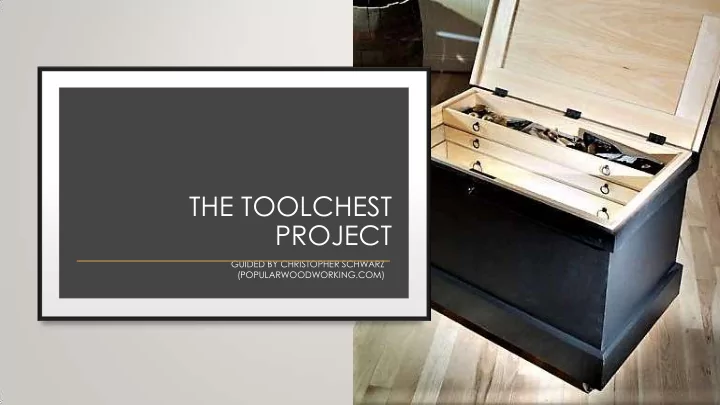

THE TOOLCHEST PROJECT GUIDED BY CHRISTOPHER SCHWARZ (POPULARWOODWORKING.COM)
GROUP COMPOSITION • Initially four members expressed interest, but when we started with the first meeting, only two could make it. • Eventually only Anzette Snyders managed to begin and complete the chest .
• Christopher Schwartz (Popular Woodworking) preaches 12 rules for toolchests. • He designed this tool chest, that he PROJECT calls a “traditional English tool chest”, DESCRIPTION or “the anarchist’s tool chest”, AND ANY applying his 12 rules. SPECIFIC • SketchUp plans, book and video DIFFICULTIES bought online at www.shopwoodworking.com (the online shop of Popular Woodworking / www.popularwoordworking.com).
PROJECT DESCRIPTION AND ANY SPECIFIC DIFFICULTIES (CONT) • This project was chosen specifically due to its focus on acquiring the skill to make dovetails by hand – and it DID provide ample practice! • Another reason, apart from it being pleasing to look at: it is also essential to a workshop. • Plans’ dimensions were imperial – converting plans to metric • Finding suitable wood: light but strong. CS recommended American white pine, so I chose Oregon… - bad choice! • Anzette chose meranti
MODUS OPERANDI OF THE GROUP • Shared Christopher Schwarz’s book, plans and videos; team had to peruse to get acquainted with project scope and challenges, etc • Established WhatsApp group for easy communication and consultation • Had an initial meeting to discuss the matter of which wood; what is prescribed vs what is own choice; project milestones; how frequently to meet, etc. • Had one follow-up meeting to track progress, discuss challenges experienced, caution on tricky steps ahead and share advice • Regular meetings was a challenge. But the electronic material provided excellent guidance
NEW OR REFINED WOODWORKING TECHNIQUES OR SKILLS The project takes one through mastering a number of skills/techniques, such as: • Laminating and levelling/smoothing wide panels • Sawing plumb, square and straight by hand • Chisel work… and sharpening chisels to cut across grain • Dovetails, dovetails, dovetails – on chest, skirts and drawers … 74, all by hand • Deep mortise & tenon joints • Making the skirts with dovetails to fit tightly onto the chest
NEW OR REFINED WOODWORKING TECHNIQUES OR SKILLS (CONT) • Innovation to solve unforeseen challenges, e.g. • cutting out “surprise packets” and plugging them • lid panel cracking; • Clamping jig to hold wide panels for dovetailing work
MAJOR PROBLEMS AND HOW THEY WERE OVERCOME • Anzette will talk about her own challenges she faced. • In my case: there were several problems, most prominent being: 1. Cross-grain paring on Oregon pine 2. “Surprise packets” – closed resin wells inside some Oregon planks that cracked open during/after planning 3. The lid’s floating panel cracked when already fitted and rails & styles already glued.
HOW THE CHALLENGES WERE OVERCOME: “SURPRISE PACKETS” Applied Denis Lock’s plugging method with a router (“pattern routing inlay”), using one template, one straight bit and two different sized guide bushes
HOW THE CHALLENGES WERE OVERCOME: CRACKED FLOATING PANEL PROBLEM: NO SOLUTION: MAKE SURFACE TO CLAMP PLUG A SURFACE TO CLAMP! CLAMP!
IS SUCH A GROUP PROJECT WORTHWHILE? Yes, as long as it is – • Sufficiently challenging • There is more than one committed member • Geographic proximity is important • It is exciting to learn from fellow woodworkers and see how they solve difficulties during a practical project
THE TWO CHESTS THAT WERE MADE
CHRIS SCHWARZ’S 12 “RULES” FOR TOOLCHESTS 1. As Long as Your Tool Plus Some 2. Tall Enough to Make a Human Tripod 3. A Depth to Match Your Reach 4. Reduce the Weight; Increase the Joinery 5. Make a Thick Shell 6. The Bottom Should Be Nailed 7. Skirts, Dust Seals & Miters 8. Don’t Blow it on the Lid 9. Divide the Bottom Layer 10. Trays 11. Sticking Stuff to the Lid & Walls 12. Paint the Outside
Recommend
More recommend